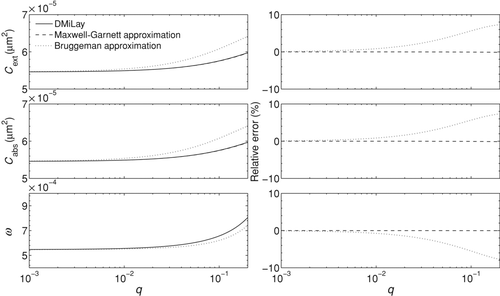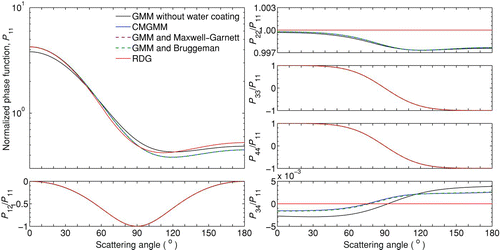Abstract
The effect of water coating of constituent monomers on the optical single-scattering properties of fractal soot aggregates is investigated numerically using core-mantle theory and approximations involving two effective medium theories. A cluster–cluster aggregation algorithm is used to numerically generate fractal aggregates, and the core-mantle Generalized Multi-particle Mie (GMM) method is used to compute the exact single-scattering properties of soot aggregates with water-coated monomers. Comparisons are then made with results obtained using approximations that combine either the GMM method or the Rayleigh–Debye–Gans (RDG) method with either the Maxwell-Garnett or the Bruggeman effective medium approximation (a total of four approximation methods). The optical properties calculated are the extinction and absorption cross sections, the single-scattering albedo, and the phase matrix of water-coated fractal aggregates; these calculations are done for two wavelengths, 0.628 μm and 1.1 μm. Water coating of the fractal aggregates is shown to increase the extinction and absorption cross sections, the single-scattering albedo, and forward scattering, but decrease backward scattering. The combination GMM + Maxwell-Garnett gives approximations that are quite good over a range of coating thicknesses and aggregate size. The combination GMM + Bruggeman performs less well, overestimating the extinction and absorption cross sections and underestimating the single-scattering albedo. In the case of RDG, the better combination is with the Bruggeman approximation, but the errors involved are greater than with the GMM + Maxwell-Garnett combination. Results from simple idealized calculations indicate that the differences between results with the Maxwell-Garnett and Bruggeman approximations should be even larger in cases of aerosol cores that are less absorptive than soot.
Copyright 2012 American Association for Aerosol Research
1. INTRODUCTION
It is generally recognized in the atmospheric science community that soot aerosols released from low temperature fuel combustion processes play a significant role in the radiation of Earth's atmosphere by scattering and absorbing both solar and terrestrial radiation (Sorensen Citation2001; Kolokolova et al. Citation2006; Mishchenko et al. Citation2007). Modeling the radiative impact of soot clusters in a manageable way in climate models is therefore an important matter. In humid atmospheric environments, soot aggregates frequently acquire a water coating, which introduces further complexity to the problem of determining the optical properties of the aggregates (Hanel Citation1976; Jones and Friedman Citation2000; Kocifaj et al. Citation2008; Yin and Liu Citation2010). As described below, this study conceptually separates the geometric effects of aggregate structure from the effects of water coating and focuses on the latter. Two widely used methods of modeling coating effects, the Maxwell-Garnett (Garnett Citation1904, Citation1906) and the Bruggeman (Bruggeman Citation1935; Landauer Citation1978) effective medium approximations, are compared in the special case of aggregates constructed from homogeneous spherical particles coated with water layers of uniform thickness. This special case is clearly a great simplification of coated soot aggregates as they actually occur. However, the simplification provides a model for which there is an exact theory available. Hence, by applying the effective medium approximations, which do not themselves require the sphericity or uniform layer assumptions, in the simplified case, it is possible to determine the magnitude of errors introduced by each of the approximations. The exact theory is called the “core-mantle Mie theory” (Aden and Kerker Citation1951). It has been argued (Bergman Citation1978; Lucarini et al. Citation2005) that the Maxwell-Garnett theory should only be valid for thick water coatings, and that as the coating thins, the symmetrical Bruggeman approximation (Landauer Citation1978) is more appropriate. Using the same method of aggregation in each case, it will be shown that in an important case of water coating the Maxwell-Garnett theory in fact is more reliable than the Bruggeman theory over a wide range of water coating thicknesses and cluster sizes.
Scanning Electron Microscopy (SEM) analyses and Transmission Electron Microscopy (TEM) image measurements indicate that soot particles commonly occur in clustered aggregates consisting of one to several hundred similar-sized (radius range 0.01–0.025 μm) “primary” particles (Koylu and Faeth Citation1992). Modeling the aggregate structure presents a challenge involving considerations of primary particle composition, size, and shape, as well as aggregate configuration (Dobbins et al. Citation1998; Sorensen Citation2001; Posfai et al. Citation2004; Tian et al. Citation2004; Gwaze et al. Citation2006; Kolokolova et al. Citation2006; Dukhin et al. Citation2007). In order to model the cumulative effect of a very large number of such aggregates on atmospheric radiation processes, it is natural to seek simplification through use of some kind of “homogenization” of physical properties. An extreme form of simplification is an “equivalent sphere” approximation for entire aggregates, the hope being that an ensemble of spherical particles with suitably adjusted characteristics can have the same statistical scattering properties as an ensemble of aggregates. This approach has serious weaknesses: efforts to capture the monomer–monomer scattering interactions within an aggregate in such strong homogenization approaches have been unsuccessful to date, particularly when polarization properties are considered (Liu and Mishchenko Citation2007; Li et al. Citation2010). Thus, it appears necessary to retain the fractal nature of aggregates in modeling scattering properties that include polarization.
FIG. 1 A fractal aggregate consisting of 60 water-coated monomers, simulated by the diffusion-limited CCA algorithm. The morphological factors of the aggregate are D f=1.82, k f=1.19, and q=0.2.
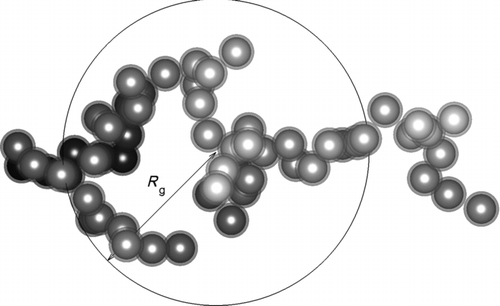
In order to focus on the representation of water coating in a context where an exact theory is available, we treat the primary particles, or “monomers,” as uniformly sized spheres, either bare or coated with water. The aggregates are constructed as collections of point-attached (non-overlapping) monomers of radius “a” arranged according to an empirically based statistical scaling law (Forrest and Witten Citation1979; Sorensen and Roberts Citation1997; Sorensen Citation2001; Liu and Mishchenko Citation2005, Citation2007; Mackowski Citation2006). The law depends on three geometric parameters aside from a. The first is Rg the radius of gyration, which is a measure of the spread of monomers about their mean position ()
In Equation (Equation1) ![]() is the displacement of the ith monomer's center from the cluster mean position
is the displacement of the ith monomer's center from the cluster mean position ![]() and N is the number of monomers in the aggregate. N will be called the “size” of the aggregate.
and N is the number of monomers in the aggregate. N will be called the “size” of the aggregate.
The two other parameters are Df the fractal dimension, and kf the “fractal prefactor.” They appear in an empirical statistical scaling power law that relates the size of an aggregate to the nondimensional length scale R g/a. The law can be expressed in two equivalent forms:
The second form of the law indicates how the key parameters Df and kf may be empirically determined by linear regression from measurements of N, a, and R g.
The single-scattering properties of soot aggregates are determined by the composition of the monomers as well as their geometric arrangement, or “morphology” of the constituent monomers. For fractal aggregates the morphology is characterized, for a given size N, by the fractal parameters as in EquationEquation (2). Numerical models of varying degrees of complexity have been developed to calculate the single-scattering properties of fractal aggregates, among them the superposition T-matrix method, the Generalized Multi-particle Mie (GMM) method, and, perhaps the simplest, the Rayleigh–Debye–Gans (RDG) method. The RDG method neglects the multiple scattering effects within the aggregates and can only give rough approximations for the cross sections, having relative errors that under certain conditions may be larger than 15% (Farias et al. Citation1996; Sorensen Citation2001). Liu and Mishchenko (Citation2005, Citation2007), and Liu et al. (2008) used the more sophisticated superposition T-matrix method to study scattering properties of soot aggregates with homogeneous carbonaceous soot monomers, and explored the impact of different structural and optical parameters on the ensemble-averaged, single-scattering properties of randomly orientated fractal aggregates. Their results show the effects of aggregate fractal morphology and size on the extinction, scattering, and absorption properties of soot aerosols to be significant.
As environmental relative humidity increases, the geometric size of an atmospheric aerosol increases significantly due to acquisition of a surface water coating (Hanel Citation1976; Jones and Friedman Citation2000; Kocifaj et al. Citation2008; Yin and Liu Citation2010). Hanel (Citation1976) studied the effect of relative humidity on atmospheric aerosol particles in moist air and found that small submicron-sized particles may increase in volume by more than 25% when the relative humidity exceeds 70–80%. In moist air, then, it should be expected that aggregates would have some form of water coating. In order to make use of the core-mantle exact theory described below, the simplifying assumption is made that the coating occurs at the level of monomers, so the aggregates in this study consist of inhomogeneous (water-coated) monomers with correspondingly larger individual radii. Examination of the effects of other forms of water coating that are more realistic is beyond the scope of this paper. Liu and Mishchenko (Citation2005) showed that the increase in size of homogeneous monomers in aggregates, which results in increased overall aggregate size, has a major effect on the single-scattering properties, strengthening the forward scattering and weakening the backward scattering. More recently, Yin and Liu (Citation2010) studied the scattering properties of aggregates composed of monomers coated by varying thicknesses of water, using the Maxwell-Garnett effective medium approximation to treat the monomers as homogeneous spheres. They found that the extinction, absorption, and scattering cross sections of the aggregates increased in the presence of the water coating.
Single uniformly coated monomers can be treated with the core-mantle theory that is an outgrowth of the Lorenz–Mie theory. The latter theory provides an analytical method for calculating the light scattering properties of single homogeneous spherical particles and has been generalized considerably. In particular Aden and Kerker (Citation1951) extended the theory to the case of a sphere with a concentric spherical shell, i.e., an inhomogeneous “core-mantle” sphere, and made it possible to treat exactly the individual coated monomers of aggregates. This core-mantle Mie theory differs from the homogeneous Lorenz–Mie theory by replacing the spherical harmonic amplitude coefficients of the external field with those for the core-mantle spheres (Aden and Kerker Citation1951). The core-mantle theory is implemented in the use of a computer code, the DMiLay.f code, developed by Toon and Ackerman (Citation1981). It has been successfully applied to compute the scattering properties of single core-mantle spheres (Hong et al. Citation2008). Xu (Citation1995, Citation1996, Citation1997) and Xu and Gustafson (Citation2001) continued the development to produce what is known as the GMM method to deal with aggregates of arbitrary size and configuration, formed from monomers that are homogeneous spheres of possibly different radii and compositions. This GMM method was recently used to calculate the single-scattering properties of fractal aggregates by Van-Hulle et al. (Citation2002), Liu and Smallwood (Citation2010, Citation2011), and Li et al. (Citation2010). By replacing the Lorenz-Mie theory for homogeneous particles with the core-mantle Mie theory, i.e., providing the amplitude coefficients given by the core-mantle Mie theory, the GMM was extended to compute the scattering properties of the aggregates with coated inhomogeneous monomers (Xu and Khlebtsov Citation2003). It is this version, designated as the “core-mantle GMM (CMGMM)” method, that is used here.
Results obtained using the core-mantle method (in the case of single monomers) or the CMGMM method (in the case of aggregates) are taken as providing “standards of truth.” Using these standards, the relative success of the two effective medium theories in approximating the effects of monomer water coating on the optical scattering properties is investigated. The Maxwell-Garnet-based calculations of Yin and Liu (Citation2010) are revisited and extended by both assessing the level of error involved in using that approximation, and by including analysis of results obtained using the Bruggeman approximation. First, water-coating effects for single monomers are examined, comparing each of the approximations with the exact results of core mantle theory. The CMGMM method can then be used to exactly compute the ensemble-averaged, single-scattering properties of soot aggregates with water-coated monomers. In separate calculations, the aggregate water-coated monomers are first approximated as homogeneous using each of the Maxwell-Garnett and Bruggeman effective medium approximations to get the equivalent dielectric constants. Then each of the RDG and GMM methods is used to calculate the scattering properties of aggregates constructed of homogeneous monomers having these equivalent dielectric constants.
The summary section includes a direct comparison of the Maxwell-Garnett and Bruggeman approximations themselves in a way that suggests that differences in polarization properties found in our study using the two approximations may be even greater for other less absorptive core aerosols than soot.
2. MODEL AND METHODOLOGY
2.1. Generation of Fractal Aggregates
This study does not concern the sensitivity to fractal parameters, and the parameters are fixed at the values D f=1.82 and k f=1.19 as suggested by the Sorensen and Roberts’ (Citation1997) diffusion-limited cluster aggregation simulation.
Diffusion-limited algorithms, including particle–cluster aggregation (PCA) and cluster–cluster aggregation (CCA) methods, have been commonly used in determining the relative positions of monomers of an aggregate. Here an improved CCA algorithm developed by Filippov et al. (Citation2000) is used. Starting from single monomers, the algorithm generates large aggregates iteratively by randomly adding two previously constructed smaller clusters, of sizes N 1 and N 2 each individually following the statistical scaling law, to produce a cluster of size N 1 + N 2 that also satisfies the scaling law (for details see Filippov et al. Citation2000). Iteration proceeds until a cluster of desired size is constructed. At each iteration step, the scaling law imposes constraints that only incompletely specify the attachment point and relative cluster orientation for joining the clusters, and a pseudo-random number generator is used to pick points and orientations consistent with the scaling law constraints. The aggregate assembled through this sequence of calls to the random number generator becomes a member of an ensemble of same-sized aggregates that is created by repeating this construction a number of times (see below). Averages are then taken over the scattering simulation results obtained with individual ensemble members.
The volume fraction of monomer water coating, which in atmosphere is determined by the ambient relative humidity, is specified in terms of parameter q, the ratio of thickness h water of a uniform water coating to the radius of the spherical soot monomer core a,
The volume fraction of the soot core f soot is then given by
Consistent with the range reported in Koylu and Faeth (Citation1992), the monomers of the soot are assumed to have radius, a=0.015 μm. The values of q range from 0.01 to 0.2 in steps of 0.01: this range of q values leads to a corresponding range of percentage volume increase for the composite monomers of approximately 3–73%, and a volume fraction range of approximately 0.89–0.69. shows an example of a fractal aggregate generated by the CCA algorithm with our chosen fractal parameters and q=0.2. The figure indicates the difference between the aggregate's radius of gyration, R g and the maximal linear extent of the aggregate.
2.2. Effective Medium Approximations
Models using effective medium approximations aim to replace an inhomogeneous particle that has internal variation of dielectric constant with a homogeneous particle that has a single “effective” dielectric constant, ϵeff, whose value yields approximately the same scattering properties. For two-component materials with the dielectric constants of ϵ1 and ϵ2, the effective dielectric constant given by the Maxwell-Garnett theory (Garnett Citation1904, Citation1906) is defined to satisfy the following relation:
In the framework of the conventional Maxwell-Garnett theory, the volume fraction of the inclusion is assumed to be “small.” For the range of volume fractions of interest in this study, the approximation would not appear to be reliable. The Bruggeman theory (Bruggeman Citation1935; Landauer Citation1978), on the other hand, is a widely used effective medium approximation that is designed to give a symmetric description for the effective dielectric constant of two-component materials with no limit on the volume fractions of any constituent material. The form of the Bruggeman approximation used in this study has a generalization to account for inclusions with different shapes by Zeng et al. (Citation1988). In the case of just two constituents, the effective dielectric constant is thus defined to satisfy
Approximation of dielectric properties of water-coated soot aerosols will introduce errors in calculations of such integral quantities as the extinction and absorption cross sections and the single-scattering albedo, and also errors in calculations of aerosol polarization properties.
2.3. Mueller Matrix and the Normalized Phase Function
The important quantities in determining polarization properties are entries in the Mueller (or “phase”) matrix. This matrix relates the four-vectors of Stokes parameters for scattered and incident beams, and generally has 16 components. But what is of the most direct importance for atmospheric applications is the matrix that results from statistical averages over an ensemble of soot aggregates. Assumptions of basic symmetries in the ensemble (van de Hulst Citation1957) then allow restriction of consideration to an “ensemble-averaged” Mueller matrix that is in block-diagonal form, having only six independent elements denoted below:
The Stokes parameter I is the beam intensity, Q and U are intensities of linearly polarized components, and V is the intensity of the circularly polarized component. The subscripts “i” and “s” refer to incident and scattered beams. C sca is the scattering cross section, and r is the distance from the observation point to the scatterer. It is common in applications to focus on the normalized phase function P 11, a measure of the overall scattering intensity (at a given scattering angle), together with the normalized phase matrix element ratios P 12/P 11, P 12/P 11, P 22/P 11, P 33/P 11, P 34/P 11, and P 44/P 11 (also functions of scattering angle). The normalization involves the scattering cross section as indicated in EquationEquation (7). These ratios can help characterize a scatterer, and are used in the construction of algorithms for retrieval of aerosol optical properties from satellite observations. The negative of the ratio P 12/P 11 is conventionally taken to be a measure of the degree of linear polarization of the scattered radiation when the incident radiation is unpolarized (e.g., natural light). The ratio P 22/P 11 is highly sensitive to the non-sphericity of the scatterer (Bohren and Huffman Citation1998; Mishchenko et al. Citation2002), and so is an indication of the particle's non-sphericity. The ratio P 34/P 11 measures the scatter's ability to change between linear and circular polarization. This ratio and the remaining two should become increasingly important as circularly polarized lidar technology comes into use.
FIG. 2 The extinction and absorption cross sections and the single-scattering albedo of a single water-coated soot sphere as functions of relative thickness of the water coating. The core radius of the soot monomer is 15 nm, and the incident wavelength is 0.628 μm.
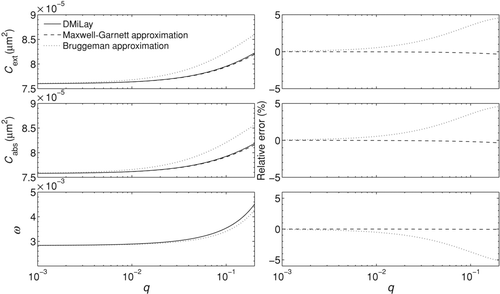
In the case of Rayleigh scattering for a spherical particle, the matrix simplifies further: P 22 = P 11, P 44 = P 33, and P 34 = P 43 = 0 (Chandresekhar Citation1960; Hansen and Travis Citation1974). In RDG treatments of scattering by fractal aggregates (Sorenson 2001), the matrix for single-particle Rayleigh scattering is multiplied by a structure function f(θ) that depends on the fractal dimension D f and gyration radius R g: the RDG calculations in this study use the Dobbins–Megaridis structure function (Dobbins and Megaridis Citation1991). Note that in the RDG approximation the ratios P 22/P 11 = 1 and P 34/P 11 = 0 are fixed; evidence of consequent errors will be seen in some of the results below.
2.4. Ensembles of Aggregates
For each choice of aggregate of size N and water coating thickness, an averaging procedure is conducted in two stages. An aggregate ensemble of K members is created. Calculations of averaged coefficients of extinction and absorption cross sections, and phase matrix elements C ext,k , C abs,k , and P mn,k (θ) for 1000 orientations of the same aggregate member “k” are calculated, where θ is the scattering angle. Then averages of these averaged quantities are taken over ensemble members as follows:
In EquationEquations (10) and Equation(11) the scattering cross section is defined by C sca=C ext−C abs. The number K of aggregates in each ensemble is set at K = 20 in the present study, with justification provided below.
3. RESULTS AND DISCUSSION
The refractive indexes of soot and water are m soot=1.75+0.435i and m water=1.33+0i at wavelength 0.628 μm and m soot=1.82+0.6i and m water=1.32+0i at wavelength 1.1 μm (Chang and Charalampopoulos Citation1990; D’Almeida et al. Citation1991). The complex dielectric constant ϵ is related to the complex refractive index by m 2=ϵ.
The first effects of water coating to be considered are those for a single monomer. shows results for an incident wavelength of 0.628 μm a monomer core radius of a=0.015 μm, and a range of coating thicknesses q from 0.01 to 0.2, using the DMiLay.f code, the Maxwell-Garnett theory, and the Bruggeman theory. In comparison with the core-mantle exact results, the Maxwell-Garnett theory is seen to give quite accurate approximations for the single-scattering properties of a single core-mantle sphere. The results from the Bruggeman theory, however, are not as good: The relative errors increase as the water coating thickness increases to reach approximately 5% when q is 0.2.
shows that for an incident wavelength of 1.1 μm, the Maxwell-Garnett approximation once again works well, and the Bruggeman approximation gives increasingly poorer approximations with increase in the water coating thickness. Although the Maxwell-Garnett approximation is theoretically justifiable only for inclusions with small volume fractions, it apparently outperforms the theoretically more general Bruggeman approximation, in the case of single monomers, over an atmospherically relevant range of coating thicknesses.
shows changes to scattering properties brought about by water coating of fixed thickness, as reflected in the phase functions and other non-zero phase matrix elements for a single monomer. In order to give some indication of the size and composition effects, the figure includes results for two different uncoated monomers: one simply the core soot monomer, and the second a pure soot monomer with radius expanded to match that of the coated monomer. The incident wavelength is 0.628 (results are not qualitatively different at 1.1 μm), the radius of the soot core is 0.015 μm, and the relative thickness of water coating is 0.1. At the small size parameter 2πa/λ of soot monomers, approximately 0.15 for an incident wavelength λ of 0.628 μm and 0.086 for 1.1 μm, the single scattering of these small monomers may be treated as Rayleigh scattering. From the left column of plots it can be seen that the effect of the coating on most of the phase matrix elements, as shown by the DMiLay results, are small. Furthermore, the effective medium theories seem to produce results that are in good agreement with each other and with the DMiLay results; the corresponding curves in each panel of the figure nearly coincide. The largest effect of water coating is in the ratio P 34/P 11, which the coating evidently reduces: in this case the enlarged soot monomer shows a qualitatively different response from both the exact method and the two approximations. The right column of plots allows closer comparisons by considering relative differences for quantity Q,
FIG. 4 The normalized phase matrix elements of a single soot monomer with and without water coating, and their relative differences compared to a monomer without water coating. The core radius of the soot monomer is 15 nm, the relative thickness of the water coating is q=0.1, and the incident wavelength is 0.628 μm. (Color figure available online.)
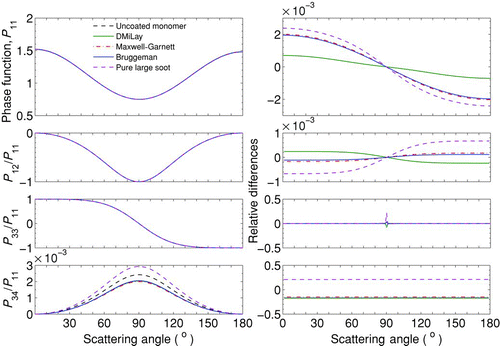
It can be seen that water coating increases the forward scattering and decreases the backward scattering phase functions in all cases. The size of the relative difference is overestimated by each of the Maxwell-Garnett and Bruggeman approximations, but by no more than about 0.125% in the forward and backward directions, while the enlarged soot monomer amplifies these errors. The ratio P 12/P 11, which is related to the degree of linear polarization, shows qualitatively different relative differences from those given by the exact DMiLay calculation: specifically, the exact calculation shows that coating increases the value for forward angles and decreases it for backward angles, while the effective medium results show (smaller) changes of the opposite signs. Once again the enlarged soot monomer amplifies the changes predicted by the effective medium theories. The large relative errors in P 33/P 11 around the scattering angle 90o are due to the fact that the absolute values are very close to zero. The same calculations for incident wavelength 1.1 μm produced results qualitatively similar and are not shown.
Aggregates of water-coated monomers are considered next. Exact values for the phase matrix elements, extinction cross section C ext, absorption cross section C abs, and single-scattering albedo ω of ensemble-averaged, water-coated fractal aggregates with random orientations are computed using the CMGMM method at two wavelengths of 0.628 and 1.1 μm. contains a summary of results on integral quantities for a single value of water coating thickness (q = 0.1). With ensemble size K = 20, ensemble-averaged single-scattering properties of the aggregates with N = 200 water-coated monomers, calculated by the three methods, and the ratios of their standard deviations σ to their mean values are listed in . The differences in the normalized single-scattering properties of different aggregates, with the same fractal parameters, are overall rather small for the three methods, with ratios of the standard deviations to the corresponding mean values less than 0.5% for the extinction and absorption cross sections and less than 3.5% for the single-scattering albedo. Similar results were obtained by Liu and Mishchenko (Citation2007) and Liu and Smallwood (Citation2010). The relatively small standard deviations indicate that a choice of K = 20 for ensemble size is sufficiently large for reliable statistics on mean quantities. Liu and Smallwood (Citation2010) also found that K = 20 was sufficient to get converged results, and stated that a choice of K = 10 can be adequate.
TABLE 1 The ensemble-averaged extinction, absorption cross sections, and single-scattering albedo and the ratio of their standard deviations σ to the mean values of 20 different water-coated aggregates with the same fractal parameters of D f=1.82, k f=1.19, a=15 nm, N=200, and q=0.1
FIG. 5 The extinction and absorption cross sections and the single-scattering albedo of water-coated soot aggregates, with N = 200, as functions of the relative thickness of the water coating. The incident wavelength is 0.628 μm. (Color figure available online.)
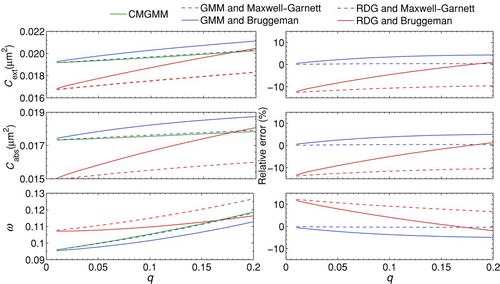
shows ensemble-averaged extinction and absorption cross sections and the single-scattering albedo of fractal aggregates, consisting of 200 water-coated monomers, as a function of relative thickness q at an incident wavelength of 0.628 μm. The dependence of optical properties on q are computed using the CMGMM method as well as the combinations of the effective medium approximations with each of the GMM and RDG methods. According to the results using the CMGMM method, as the relative thickness of water coating increases from 0.01 to 0.2, the extinction cross section of the fractal aggregates increases by 5% approximately, the absorption cross section increases by 3% approximately, and the single-scattering albedo increases by over 20%. The results with the Maxwell-Garnett approximation agree quite well. Yin and Liu (Citation2010) also used the Maxwell-Garnett approximation and reported qualitatively similar results but did not consider error estimates. Here, with the inclusion of results with exact calculations using the CMGMM method, we are able to estimate and compare the relative errors introduced by each of the effective medium approximations. When combined with GMM, each of the equivalent homogeneous approximations overestimates the extinction and absorption cross sections and underestimates the single-scattering albedo. The combination of GMM with the Maxwell-Garnett approximation results in relative errors of less than 0.5%, but the combination of GMM with the Bruggeman approximation gives relative errors of approximately 5%, an order of magnitude larger. Surprisingly, what seems to work better (i.e., produces results closer to those of CMGMM) in combination with RDG is not the Maxwell-Garnett approximation, but instead the Bruggeman approximation. However, for low values of relative thickness q the errors using RDG and the Bruggeman approximation are nevertheless large (there are underestimates of the cross sections and overestimates of the single-scattering albedo, each on the order of 10–15%). Only for relative thicknesses in excess of 0.15 does the combination of RDG with an effective medium approximation become competitive with the combination of GMM with an effective medium approximation. At present it is not clear why in using RDG the better-performing effective medium approximation is Bruggeman, while in using GMM the better one is Maxwell-Garnett. Similar conclusions and results (not shown) were obtained for the near-infrared wavelength 1.1 μm, although at this wavelength the Bruggeman approximation when combined with GMM gives relative errors as large as 8%.
and show the ensemble-averaged phase function and other non-zero normalized phase matrix elements, where again the average is over spatial orientation as well as realization, for fractal aggregates consisting of monomers with and without water coating. The relative thickness q of the water-coated aggregates is 0.1, the number of monomers for the fractal aggregate is 200, and the incident wavelengths are 0.628 and 1.1 μm. It is evident from and that P 11, P 22/P 11 and P 34/P 11 are quite sensitive to water coating, whereas P 12/P 11, P 33/P 11, and P 44/P 11 are essentially unaffected by it (the corresponding curves for the latter three ratios virtually coincide). In the presence of water coating, the forward scattering increases and the backward scattering decreases. The results are overall consistent with those shown in , in particular the enhanced forward scattering and suppressed backward scattering, although the significant suppression of P 34/P 11 caused by the coating shifts more to the forward direction in aggregate ensemble averages. In the two figures, curves corresponding to the GMM method in combination with each of the two effective medium approximations coincide. As a consequence, the CMGMM method, on the one hand, and the GMM combined with either the Maxwell-Garnett or the Bruggeman effective medium approximations, on the other, are seen to give very similar normalized values for the phase function and all other non-zero elements of the phase matrix. The relative errors in these normalized values are small, but different in the cases of two approximations in a manner that may be expected from the results with monomers. (This is briefly described below in connection with size variations.) However, it is important to recognize that the errors in the normalizing factor C sca computed using the two approximations are not as close in magnitude, and hence the Maxwell-Garnett approximation gives a better overall result for the phase matrix elements. The figures also show that the RDG method does well in its representations of P 11, P 12/P 11, P 33/P 11,and P 44/P 11: the RDG curves in these cases coincide with the curves for the two effective medium approximations. However, the RDG method evidently performs poorly on P 22/P 11 and P 34/P 11.
FIG. 6 Comparison of the non-zero phase matrix elements of individual fractal aggregates with and without water coating. The two GMM curves coincide in all plots. They also coincide with the RDG curve for P 11, P 12/P 11, P 33/P 11, and P 44/P 11. The morphological factors of the aggregates are: D f=1.82, k f=1.19, a=15 nm, N=200, and the relative thickness of the water coating is q=0.1. The incident wavelength is 0.628 μm. (Color figure available online.)

FIG. 8 The extinction and absorption cross sections and single-scattering albedo of water-coated soot aggregates, with relative thickness q=0.1 as functions of the number of monomers per aggregates. The incident wavelength is 0.628 μm. (Color figure available online.)
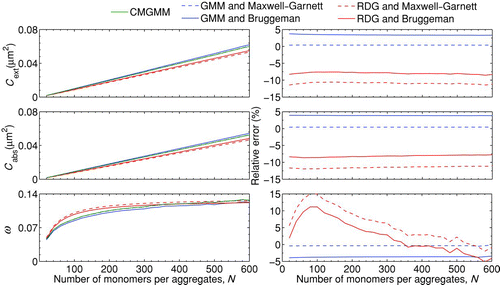
FIG. 9 Comparison of the Bruggeman and Maxwell-Garnett effective dielectric constants for soot fractions varying between 0 and 1 in the visible (λ=0.628 μm) and near-infrared (λ=1.1 μm) cases. The upper figures compare ![]()
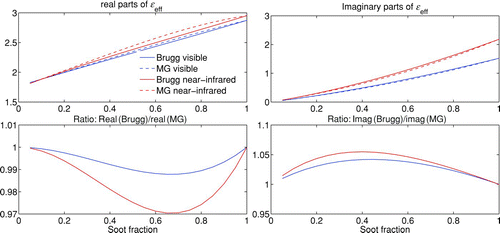
shows the extinction and absorption cross sections and the single-scattering albedo of water-coated fractal aggregates, calculated by the CMGMM method, as well as by combinations of the effective medium approximations with GMM and RDG. These optical properties are shown as functions of the number of monomers per aggregate at wavelengths 0.628 and 1.1 μm. The relative thickness of the water coating is q=0.1 for all the aggregates. For the figure, 30 values of N are chosen from N=20 to N=600 in steps of 20, and each of them has ensemble-averaged values of 20 fractal-parameter-equivalent aggregates. The figure shows that the Maxwell-Garnett approximation in combination with GMM gives the best approximations for the single-scattering properties of the core-mantle aggregates with different number of monomers: the corresponding curves in the left column of panels visually coincide, with the very small relative errors shown in the right column of panels. GMM combined with the Bruggeman approximation gives overestimates of the extinction and absorption cross sections and underestimates of the single-scattering albedo, by approximately 4% at wavelength 0.628 μm and by approximately 6% at wavelength 1.1 μm (not shown). The RDG method, in combination with either of the effective medium approximations, performs relatively poorly over all sizes of aggregates for cross sections, but the combination of Bruggeman with RDG does well in representing the single-scattering albedo in the intermediate range of aggregate sizes 350–450.
4. SUMMARY
The present results indicate that water coating of the fractal aggregates increases the forward scattering, extinction and absorption cross sections, and single-scattering albedo, but decreases the backward scattering.
Considering together the results on the phase matrix, cross sections, and single-scattering albedo computed from the CMGMM method and the general homogeneous GMM method combined with the Maxwell-Garnett and Bruggeman equivalent-medium approximations, it is evident that the Maxwell-Garnett theory provides better approximations for the single-scattering properties of water-coated fractal aggregates. The relative errors involved in using the Maxwell-Garnett approximation are less than 0.5% when compared with those given by the CMGMM method. Combination of the GMM method with the Bruggeman approximation gives errors of larger magnitude, but this level of error is not large: the approximation results in overestimates of the extinction and absorption cross sections and underestimates of the single-scattering albedo by about 6% and 8% at incident wavelengths of 0.626 and 1.1 μm, respectively. The RDG method does best when combined with the Bruggeman approximation, but produces errors in the range of 5–10% that only begin to shrink as aggregate sizes get large and water coatings get thick.
It is not easy to account from first physical principles for the differences seen in the two effective medium approximations. The results presented do not say anything definite about how the two approximations may compare if monomers are not spherical, and coatings are not shells of uniform thickness about the monomer cores. It is certainly conceivable that the errors introduced by our idealizations are as great as the differences found here between the two effective medium approximations, but whether the relative merits of the two approximations could change with a more realistic model of coating is an open question. These are topics for future investigation.
Nevertheless, given results here that the Maxwell-Garnett approximation proved to be generally the better one in combination with the GMM method, it is interesting to consider some direct comparisons of the Maxwell-Garnett and Bruggeman approximations as illustrated in our final two figures. shows two ways of comparing the estimates of ϵeff, the effective dielectric constant. The upper panels in the figure compare the real and imaginary parts of ϵeff in both visible (lower pair of curves in the upper panels) and near-infrared cases (upper pair of curves in the upper panels), as the soot fraction of the monomer varies between 0.05 and 1. That view of approximations shows what might be called “good agreement” over the range of soot values. However, if we look at the ratio of the estimates, shown in the lower two panels, we get a different impression. We see that while the Bruggeman approximation generally gives an estimate of ![]() that is a systematic but only modest reduction, by maximum amounts between 1% (visible) and 3% (near-infrared), its systematic increase in estimate of
that is a systematic but only modest reduction, by maximum amounts between 1% (visible) and 3% (near-infrared), its systematic increase in estimate of ![]() is of more significant magnitude, with maxima between 4% (visible) and 5.5% (near-infrared). It is
is of more significant magnitude, with maxima between 4% (visible) and 5.5% (near-infrared). It is ![]() that has a significant impact on the polarization properties of scatterers, as well as the absorption cross section. Notice that while the differences in approximations to m
i
that are shown in this and the next figure may appear to be small, with relative changes of the order of a few percent, within the framework of ray optics, the absorption by the particle is proportional to
that has a significant impact on the polarization properties of scatterers, as well as the absorption cross section. Notice that while the differences in approximations to m
i
that are shown in this and the next figure may appear to be small, with relative changes of the order of a few percent, within the framework of ray optics, the absorption by the particle is proportional to ![]() . Hence, small differences δmi
in values of mi
result in changes in the cross section that are approximately 250 δmi
for particles with diameter 10 μm and wavelength 0.5 μm.
. Hence, small differences δmi
in values of mi
result in changes in the cross section that are approximately 250 δmi
for particles with diameter 10 μm and wavelength 0.5 μm.
FIG. 10 The ratios of (upper panel) real parts and (lower panel) imaginary parts of ϵeff estimated by the two theories as the imaginary part of the index of refraction increases from 0 to 1. The horizontal lines correspond to ratios of values shown by the curves in the lower panels of . (Color figure available online.)
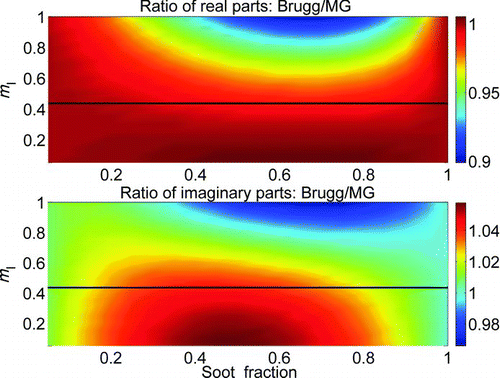
shows differences in the two estimates from another point of view. It again considers ratios of the real parts (upper panel) and imaginary parts (lower panel) of the refractive index over a range of soot fractions, but now considers in addition the effect of the soot core's absorption properties on the ratios. For this purpose, idealized substances are considered that, for the wavelength 0.628 μm, have a refraction index with real part mR
=1.75, the same as that of soot, but an imaginary part mI
ranging between 0 (water's value) past soot's value (0.435) and 1. shows the effect on the ratio of estimates in both real and imaginary cases, as a joint function of core fraction and mI
. The horizontal line in each panel of the figure corresponds to the data for the visible wavelength that are shown in the lower panels of . The structure of the joint function is surprisingly complex in the case of ratios of imaginary parts. Volume fraction by itself does not determine the relation between values of ![]() given by the two approximations: over a substantial range of core fractions, which of the two approximations gives the larger value of
given by the two approximations: over a substantial range of core fractions, which of the two approximations gives the larger value of ![]() varies, for a fixed core fraction, with the index of refraction of the core particle. Also surprising is the evidence that the differences in
varies, for a fixed core fraction, with the index of refraction of the core particle. Also surprising is the evidence that the differences in ![]() between approximations based on the two theories must be expected to be even greater than found for the particular case of soot monomers if the approximations are used to estimate optical scattering properties of less absorptive aerosols when they become water-coated.
between approximations based on the two theories must be expected to be even greater than found for the particular case of soot monomers if the approximations are used to estimate optical scattering properties of less absorptive aerosols when they become water-coated.
ACKNOWLEDGMENTS
We considerably benefited from the comments provided by two anonymous reviewers. This research was partly supported by the National Science Foundation (NFS) grant, ATMO-0803779, and the NASA grant, NNX08AP29G. Computations were carried out at the Texas A&M University Supercomputing Facility and we gratefully acknowledge the assistance of the Facility staff in porting the codes.
REFERENCES
- Aden , A. L. and Kerker , M. 1951 . Scattering of Electromagnetic Waves from 2 Concentric Spheres . J. Appl. Phys. , 22 : 1242 – 1246 .
- Bergman , D. J. 1978 . The Dielectric Constant of a Composite Material—A Problem in Classical Physics . Phys. Rep. , 9 : 377 – 407 .
- Bohren , C. F. and Huffman , D. R. 1998 . Absorption and Scattering of Light by Small Particles , New York : Wiley-Interscience .
- Bruggeman , D. A. G. 1935 . Calculation of Various Physics Constants in Heterogenous Substances I Dielectricity Constants and Conductivity of Mixed Bodies from Isotropic Substances . Ann. Phys-Berlin , 24 : 636 – 664 .
- Chandresekhar , S. 1960 . Radiative Transfer , Dover : New York .
- Chang , H. and Charalampopoulos , T. T. 1990 . Determination of the Wavelength Dependence of Refractive Indices of Flame Soot . Proc. R. Soc. A , 430 : 577 – 591 .
- D’Almeida , G. A. , Keopke , P. and Shettle , E. P. 1991 . Atmospheric Aerosols: Global Climatology and Radiative Characteristics , Hampton, VA : A. Deekpak .
- Dobbins , R. A. , Fletcher , R. A. and Chang , H. C. 1998 . The Evolution of Soot Precursor Particles in a Diffusion Flame . Combust. Flame , 115 : 285 – 298 .
- Dobbins , R. A. and Megaridis , C. M. 1991 . Absorption and Scattering of Light by Polydisperse Aggregates . Appl. Optics , 30 : 4747 – 4754 .
- Dukhin , A. S. , Fluck , D. , Goetz , P. J. , Shilov , V. N. and Dukhin , S. S. 2007 . Characterization of Fractal Particles Using Acoustics, Electroacoustics, Light Scattering, Image Analysis, and Conductivity . Langmuir , 23 : 5338 – 5351 .
- Farias , T. L. , Koylu , U. O. and Carvalho , M. G. 1996 . Range of Validity of the Rayleigh-Debye-Gans Theory for Optics of Fractal Aggregates . Appl. Optics , 35 : 6560 – 6567 .
- Filippov , A. V. , Zurita , M. and Rosner , D. E. 2000 . Fractal-like Aggregates: Relation Between Morphology and Physical Properties . J. Colloid. Interf. Sci. , 229 : 261 – 273 .
- Forrest , S. R. and Witten , T. A. 1979 . Long Range Correlations in Smoke-Particle Aggregates . J. Phys. A: Math. Gen. , 12 : L109 – L117 .
- Garnett , J. C. M. 1904 . Colours in Metal Glasses and in Metallic Films . Philos. T. R. Soc. Lond. , 203 : 385 – 420 .
- Garnett , J. C. M. 1906 . Colours in Metal Glasses, in Metallic Films, and in Metallic Solutions-II . Philos. T. R. Soc. Lond. , 205 : 237 – 288 .
- Gwaze , P. , Schmid , O. , Annegarn , H. J. , Andreae , M. O. , Huth , J. and Helas , G. 2006 . Comparison of Three Methods of Fractal Analysis Applied to Soot Aggregates from Wood Combustion . J. Aerosol Sci. , 37 : 820 – 838 .
- Hanel , G. 1976 . The Properties of Atmospheric Aerosol Particles as Functions of the Relative Humidity at Thermodynamic Equilibrium with the Surrounding Moist Air . Adv. Geophys. , 19 : 74 – 183 .
- Hansen , J. E. and Travis , L. D. 1974 . Light Scattering in Planetary Atmospheres . Space Sci. Rev. , 16 : 527 – 610 .
- Hong , G. , Feng , Q. , Yang , P. , Kattawar , G. W. , Minnis , P. and Hu , Y. X. 2008 . Optical Properties of Ice Particles in Young Contrails . J. Quant. Spectrosc. Radiat. Transfer , 109 : 2635 – 2647 .
- Jones , S. B. and Friedman , S. P. 2000 . Particle Shape Effects on the Effective Permittivity of Anisotropic or Isotropic Media Consisting of Aligned or Randomly Oriented Ellipsoidal Particles . Water Resour. Res. , 36 : 2821 – 2833 .
- Kocifaj , M. , Kundracik , F. and Videen , G. 2008 . Optical Properties of Single Mixed-Phase Aerosol Particles . J. Quant. Spectrosc. Radiat. Transfer , 109 : 2108 – 2123 .
- Kolokolova , L. , Kimura , H. , Ziegler , K. and Mann , I. 2006 . Light-Scattering Properties of Random-Oriented Aggregates: Do They Represent the Properties of an Ensemble of Aggregates? . J. Quant. Spectrosc. Radiat. Transfer , 100 : 199 – 206 .
- Koylu , U. O. and Faeth , G. M. 1992 . Structure of Overfire Soot in Buoyant Turbulent-Diffusion Flames at Long Residence Times . Combust Flame , 89 : 140 – 156 .
- Landauer , R. 1978 . “ Electrical Conductivity in Inhomogeneous Media, ” . AIP Conference Proceedings. 40:2–44 .
- Li , H. , Liu , C. , Bi , L. , Yang , P. and Kattawat , G. N. 2010 . Numerical Accuracy of “Equivalent” Spherical Approximations for Computing Ensemble-Averaged Scattering Properties of Fractal Aggregates . J. Quant. Spectrosc. Radiat. Transfer , 111 : 1127 – 1132 .
- Liu , L. and Mishchenko , M. I. 2005 . Effects of Aggregation on Scattering and Radiative Properties of Soot Aerosols . J. Geophys. Res.-Atmos. , 110 : D11211 doi:10.1029/ 2004JD005649
- Liu , L. , and Mishchenko , M. I. 2007 . Scattering and Radiative Properties of Complex Soot and Soot-Containing Aggregate Particles . J. Quant. Spectrosc. Radiat. Transfer, , 106 : 262 – 273 .
- Liu , L. , Mishchenko , M. I. and Arnott , W. P. 2008 . A Study of Radiative Properties of Fractal Soot Aggregates Using the Superposition T-Matrix Method . J. Quant. Spectrosc. Radiat. Transfer , 109 : 2656 – 2663 .
- Liu , F. S. and Smallwood , G. J. 2010 . Radiative Properties of Numerically Generated Fractal Soot Aggregates: The Importance of Configuration Averaging . ASME J. Heat Trans. , : 1 – 6 . 132(Feb) 023308
- Liu , F. S., and Smallwood , G. J. 2011 . The Effect of Particle Aggregation on the Absorption and Emission Properties of Mono- and Poly-disperse Soot Aggregates . Appl. Phys. B-Lasers O. , DOI 10.1007/s00340-011- 432-x
- Lucarini , V. , Peiponen , K. , Saarinen , J. J. and Vartiainen , E. M. 2005 . Kramers-Kronig Relations in Optical Materials Research , 21 – 26 . New York : Springer .
- Mackowski , D. W. 2006 . A Simplified Model to Predict the Effects of Aggregation on the Absorption Properties of Soot Particles . J. Quant. Spectrosc. Radiat. Transfer , 100 : 237 – 249 .
- Mishchenko , M. I. , Geogdzhayev , I. V. , Cairns , B. , Carlson , B. E. , Chowdhary , J. Lacis , A. A. 2007 . Past, Present, and Future of Global Aerosol Climatologies Derived from Satellite Observations: A Perspective . J. Quant. Spectrosc. Radiat. Transfer , 106 : 325 – 347 .
- Mishchenko , M. I. , Travis , L. D. and Lacis , A. A. 2002 . Scattering, Absorption, and Emission of Light by Small Particles , Cambridge, UK : Cambridge University Press .
- Posfai , M. , Gelencser , A. , Simonics , R. , Arato , K. , Li , J. Hobbs , P. V. 2004 . Atmospheric Tar Balls: Particles from Biomass and Biofuel Burning . J. Geophys. Res-Atmos. , 109 : D06213 doi:10.1029/2003JD004169
- Sorensen , C. M. 2001 . Light Scattering by Fractal Aggregates: A Review . Aerosol. Sci. Tech. , 35 : 648 – 687 .
- Sorensen , C. M. and Roberts , G. C. 1997 . The Prefactor of Fractal Aggregates . J. Colloid. Interf. Sci. , 186 : 447 – 452 .
- Tian , K. , Liu , F. S. , Thomson , K. A. , Snelling , D. R. , Smallwood , G. J. and Wang , D. S. 2004 . Distribution of the Number of Primary Particles of Soot Aggregates in a Nonpremixed Laminar Fame . Combust. Flame , 138 : 195 – 198 .
- Toon , O. B. and Ackerman , T. P. 1981 . Algorithms for the Calculation of Scattering by Stratified Spheres . Appl. Optics , 20 : 3657 – 3660 .
- van de Hulst , H. C. 1957 . Light Scattering by Small Particles , New York : Dover Publications .
- Van-Hulle , P. , Weill , M. E. , Talbaut , M. and Coppalle , A. 2002 . Comparison of Numerical Studies Characterizing Optical Properties of Soot Aggregates for Improved EXSCA Mearsurements . Part. Part. Syst. Charact. , 19 : 47 – 57 .
- Xu , Y. L. 1995 . Electromegnatic Scattering by an Aggregates of Spheres . Appl. Optics , 34 : 4573 – 4588 .
- Xu , Y. L. 1996 . Calculation of the Addition Coefficients in Electromagnetic Multisphere-Scattering Theory . J. Comput. Phys., , 127 : 285 – 298 .
- Xu , Y. L. 1997 . Electromagnetic Scattering by an Aggregate of Spheres: Far Field . Appl. Optics , 36 : 9496 – 9508 .
- Xu , Y. L. and Gustafson , B. A. 2001 . A Generalized Multiparticle Mie-Solution: Further Experimental Verification . J. Quant. Spectrosc. Radiat. Transfer , 70 : 395 – 419 .
- Xu , Y. L. and Khlebtsov , N. G. 2003 . Orientation-Averaged Radiative Properties of an Arbitrary Configuration of Scatterers . J. Quant. Spectrosc. Radiat. Transfer , 79 : 1121 – 1137 .
- Yin , J. Y. and Liu , L. H. 2010 . Influence of Complex Component and Particle Polydispersity on Radiative Properties of Soot Aggregate in Atmosphere . J. Quant. Spectrosc. Radiat. Transfer , 111 : 2115 – 2126 .
- Zeng , X. C. , Bergman , D. J. , Hui , P. M. and Stroud , D. 1988 . Effective-Medium Theory for Weakly Nonlinear Composites . Phys. Rev. B. , 38 : 10970 – 10973 .
